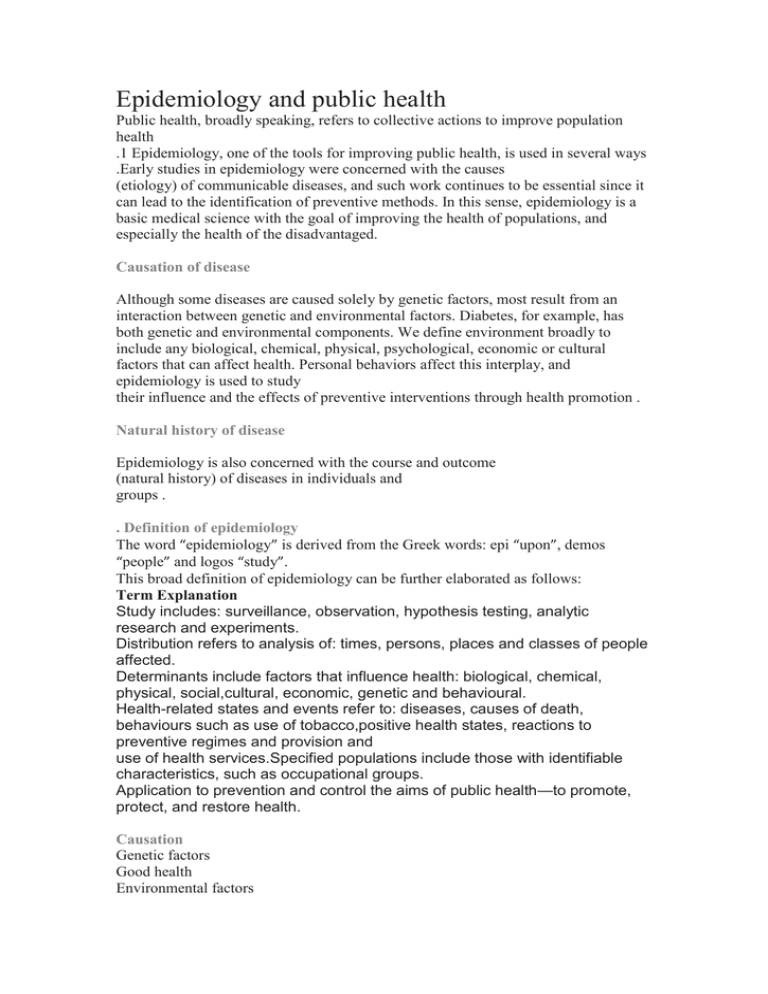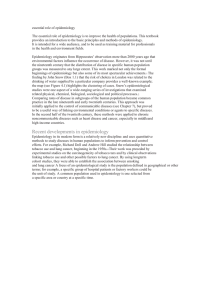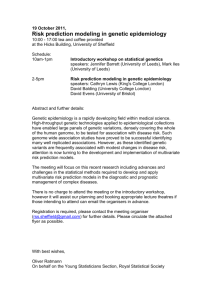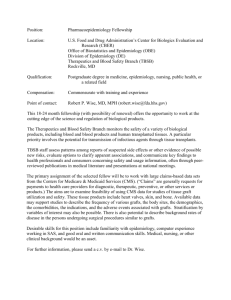Epidemiology and public health
advertisement

Epidemiology and public health Public health, broadly speaking, refers to collective actions to improve population health .1 Epidemiology, one of the tools for improving public health, is used in several ways .Early studies in epidemiology were concerned with the causes (etiology) of communicable diseases, and such work continues to be essential since it can lead to the identification of preventive methods. In this sense, epidemiology is a basic medical science with the goal of improving the health of populations, and especially the health of the disadvantaged. Causation of disease Although some diseases are caused solely by genetic factors, most result from an interaction between genetic and environmental factors. Diabetes, for example, has both genetic and environmental components. We define environment broadly to include any biological, chemical, physical, psychological, economic or cultural factors that can affect health. Personal behaviors affect this interplay, and epidemiology is used to study their influence and the effects of preventive interventions through health promotion . Natural history of disease Epidemiology is also concerned with the course and outcome (natural history) of diseases in individuals and groups . . Definition of epidemiology The word “epidemiology” is derived from the Greek words: epi “upon”, demos “people” and logos “study”. This broad definition of epidemiology can be further elaborated as follows: Term Explanation Study includes: surveillance, observation, hypothesis testing, analytic research and experiments. Distribution refers to analysis of: times, persons, places and classes of people affected. Determinants include factors that influence health: biological, chemical, physical, social,cultural, economic, genetic and behavioural. Health-related states and events refer to: diseases, causes of death, behaviours such as use of tobacco,positive health states, reactions to preventive regimes and provision and use of health services.Specified populations include those with identifiable characteristics, such as occupational groups. Application to prevention and control the aims of public health—to promote, protect, and restore health. Causation Genetic factors Good health Environmental factors (including behaviours) Ill health 4 Chapter 1 Health status of populations Epidemiology is often used to describe the health status of population groups . Knowledge of the disease burden in populations is essential for health authorities, who seek to use limited resources to the best possible effect by identifying priority health programmers for prevention and care. In some specialist areas, such as environmental and occupational epidemiology, the emphasis is on studies of populations with particular types of environmental exposure. Evaluating interventions Archie Cochrane convinced epidemiologists to evaluate the effectiveness and efficiency of health services . This means determining things such as the appropriate length of stay in hospital for specific conditions, the value of treating high blood pressure, the efficiency of sanitation measures to control diarrhoeal diseases and the impact of reducing lead additives in petrol. . Natural history What is epidemiology? 5 Good health Ill health Health promotion Preventive measures Public health services Treatment Medical care Good health Subclinical changes Clinical disease Death Recovery Proportion with ill health, changes over time Good health Time health Applying epidemiological principles and methods to problems encountered in the practice of medicine has led to the development of clinical epidemiology. Similarly, epidemiology has expanded into other fields such as pharmacy epidemiology, molecular epidemiology, and genetic epidemiology . Molecular and genetic epidemiology Molecular epidemiology measures exposure to specific substances and early biological response, by: evaluating host characteristics mediating response to external agents, and using biochemical markers of a specific effect to refine disease categories. Genetic epidemiology deals with the etiology, distribution, and control of disease in groups of relatives, and with inherited causes of disease in populations. Genetic epidemiological research in family or population studies aims to establish: a genetic component to the disorder, the relative size of that genetic effect in relation to other sources of variation in disease risk, and the responsible gene(s). Public health genetics include: population screening programs, organizing and evaluating services for patients with genetic disorders, and the impact of genetics on medical practice.





